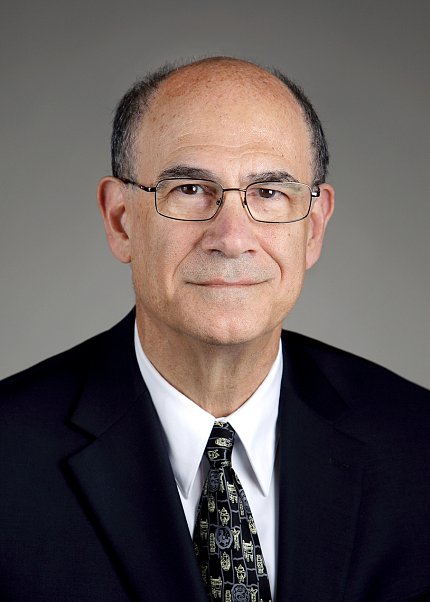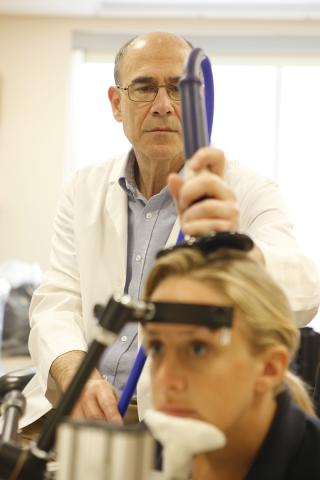NINDS’s Hallett Retires After 40 Years of Federal Service

For several decades, Dr. Mark Hallett, chief of the Medical Neurology Branch (MNB) at the National Institute of Neurological Disorders and Stroke (NINDS), has built his research career in neuroscience—expanding knowledge of how the brain controls movement, increasing understanding of movement disorders, motor learning and neuroplasticity, and making groundbreaking contributions to the field of brain stimulation. On Dec.31, he officially retired after 40 years of federal service, 38 with NINDS.
“NIH has been good to me,” said Hallett. “Having a free hand to pursue whatever ideas I had is an unusual opportunity. I will miss having a laboratory to answer questions that might cross my mind.”
A native of Philadelphia, Hallett developed an early interest in science. “I have really always been interested in science,” he said. “I first became interested in the brain in a high school psychology class.”
He earned his undergraduate degree in biology in 1965 and his medical degree in 1969, both from Harvard University. He interned at Peter Bent Brigham Hospital in Boston, received neurology training at Massachusetts General Hospital and in 1970, had a fellowship in neurophysiology and biophysics in the Laboratory of Neurobiology at the National Institute of Mental Health.
“My coming to NIH in 1970 as a fellow was not unique,” Hallett said. “I was one of the so-called Yellow Berets that came during the Vietnam era.” He was a clinical associate in the NIH Associate Training Program—a 2-year research program under the Commissioned Corps of the U.S. Public Health Service. It was during this NIH fellowship that he developed his interest in motor control.
Before coming to NINDS, in 1975 Hallett served as a Harvard University William C. Moseley Jr. traveling fellow at the Institute of Psychiatry in London. In 1976, he was chief of the Clinical Neurophysiology Laboratory at Brigham and Women’s Hospital in Boston and rose to associate professor of neurology at Harvard Medical School. In 1984, he joined NINCDS (now NINDS) as clinical director and chief of MNB’s human motor control section.

“I came back to NIH as the NINDS clinical director with a plan to continue studies in motor control,” he said. “I was interested in research as a major part of my professional activities and I knew from my experience as a fellow that NIH would be a good place to do research. And I had to find a job at that time in the Washington area, since my wife had just taken a job at the University of Maryland, and it was her turn to decide where we would be living.”
At NINDS, Hallett’s research centered on the principles of normal human voluntary movement, understanding the motor system and movement disorders including dystonia, parkinsonism and myoclonus, and the use of transcranial magnetic stimulation (TMS) and botulinum toxin to treat movement disorders. His laboratory has studied motor learning, brain reorganization in various disorders, the effects of fatigue on corticospinal excitability, the ability for fine finger control and, more recently, volition (decision-making) and its disorders, including tic and functional movement disorders.
During his time at NIH, Hallett received numerous awards and accolades, including many outside of NIH. He received a doctor of medicine honoris causa degree from the University of Hamburg, Germany, in 2017, and was made an honorary member of the European Academy of Neurology in 2018.
In 2019, Hallett received the WFN Medal for Contribution to Neuroscience from the World Federation of Neurology and the International Brain Stimulation Award from the Brain Stimulation Journal for his groundbreaking contributions to enhance the understanding of the physiological principles of brain stimulation.
Most recently, Hallett received the International Association of Parkinsonism and Related Disorders Lifetime Achievement Award and a 2022 Best Scientist Award from Research.com, a leading online academic research portal for scientists. According to the platform, Hallett is ranked as the 96th best scientist in the United States and the 138th best scientist in the world. The rankings are based on the H-index data from Microsoft Academic Graph. “A high H-index doesn’t mean you are a great scientist, but it does require publishing for a long time,” Hallett explained.
Of all of his scientific achievements, Hallett is most proud of those that relate to understanding motor control, motor learning and the pathophysiology of different movement disorders.
“Our lab’s demonstration of trans-modal plasticity in humans was another milestone,” he said. “And, of course, I am particularly proud of the fellows that I have trained and their accomplishments.”
In fact, through the years, Hallett has mentored more than 150 fellows. His laboratory pioneered the use of TMS, EEG (electroencephalogram) and neuroimaging to understand movement disorders, and many former fellows are leaders in neurology and human neuroscience around the world.
Hallett has been active in the national and international societies of clinical neurophysiology throughout his career. He is a past president of the International Federation of Clinical Neurophysiology, the American Association of Neuromuscular and Electrodiagnostic Medicine and the International Parkinson and Movement Disorder Society, and past vice-president of the American Academy of Neurology. He is a past editor-in-chief of Clinical Neurophysiology and a past associate editor of Brain. He was the founding president of the Functional Neurological Disorder Society and is now its past president.
In retirement, Hallett plans to relax and travel for enjoyment in addition to continuing in an emeritus position at NIH. “I have decided to retire because I am the right age for it. I just turned 79 and I don’t think I should be working when I am 80. I have received much advice over the years that says one should not wait to retire until you cannot do anything. If you do that you can’t enjoy your retirement, and I would like to enjoy my retirement,” he said. “And at least, for the next few years, I still will have many manuscripts to publish.”
In December, NINDS held a scientific symposium to pay tribute to Hallett and his career and to provide an overview of the current state of research in human motor control. The on-campus meeting, “From Action Potential to Free Will: Celebrating the Scientific Contributions of Mark Hallett, MD,” featured talks by leading educators and researchers in the fields of motor control and movement disorders as well as in volition and free will. Speakers discussed the wide reach and impact of Hallett’s team over the past 40 years.
To view the recording, visit https://videocast.nih.gov/watch=46497.
